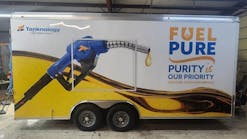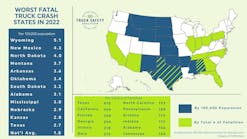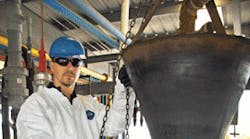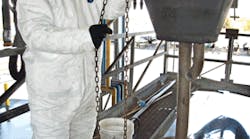Latest from Regulations
Tanknology expands fuel quality services
FMCSA to award CMV safety grants
Safety workers survey discovers high rate of non-compliance with PPE protocols
In a survey released by Kimberly-Clark Professional, 89% of safety professionals said they had observed workers not wearing safety equipment when they should have been. Twenty-nine percent said this had happened on numerous occasions.
The Occupational Safety & Health Administration (OSHA) requires the use of personal protective equipment to reduce employee exposure to hazards when engineering and administrative controls are not feasible or effective. Yet data from the Bureau of Labor Statistics (BLS) show that of the workers who sustained a variety of on-the-job injuries, the vast majority were not wearing PPE.
It is therefore no surprise that 78% of respondents said workplace accidents and injuries were the concerns most likely to keep them up at night.
Worker safety protocols was also cited as the top workplace safety issue. Twenty-eight percent of respondents chose this, while 21% selected “fewer workers.” “Insufficient management support for health and safety functions” and “meeting the safety needs of an aging workforce” tied at 18%. Lack of funds to implement safety programs was last with 8%.
Of those respondents who observed PPE non-compliance in the workplace, 69% said the primary cause was workers thinking that PPE wasn’t needed. This was followed by:
•Uncomfortable
•Too hot
•Poor fit
•Not available near work task
•Unattractive-looking
What measures have safety managers taken or plan to take in the near future to encourage greater PPE compliance? The top strategies were: improving existing education and training programs (61%) and increased monitoring of employees (48%). These were followed by:
•Purchasing more comfortable PPE
•Tying compliance to individual performance evaluations
•Purchasing more stylish PPE
•Developing incentive programs
Eye protection was found to be the “most challenging” PPE category, according to 24% of respondents. This was a disturbing, though not unexpected, finding considering that nearly three out of five workers who experienced eye injuries were found not to be wearing eye protection at the time of the accident or were wearing the wrong kind of eye protection for the job. Add to this the fact that that thousands of workers are blinded each year from work-related eye injuries that could have been prevented, and the magnitude of the problem becomes clear.
The next-highest category for noncompliance was hearing protection (18%), another disturbing finding since occupational noise-induced hearing loss is 100% preventable when proper measures are implemented. It was followed by respiratory protection/masks (17%), protective apparel (16%), gloves (14%), and head protection (4%).
Because some workplace hazards can’t be addressed by PPE, respondents were also asked about the potential health and safety issues posed by reusable rental shop towels. Ninety-one percent said they would be concerned if they found that oil, grease, heavy metal residues, or other toxic elements were in their reusable rental shop towels in levels that exceeded regulatory health-based exposure limits. Of these, 57% said they would be very concerned. Only 3% said they would not be very concerned, and not a single respondent said they would not be concerned at all.
Eighty-one percent of respondents indicated they were aware of the fact that industrial workers could transfer dangerous metals, like lead and cadmium, to their hands and clothes from rental shop towels and then potentially ingest them and/or bring these toxins home to their families, by correctly answering that this statement was true and not false. Forty-four percent said they knew that heavy metals could make their way into a facility’s operations via laundered rental shop towels from other companies’ manufacturing processes, while 36% did not.
“These findings are in keeping with the results of a new study that found elevated levels of heavy metals in tested laundered shop towels, which could result in worker exposures that exceed various health-based criteria,” said Gina Tsiropoulos, manufacturing segment marketing manager for Kimberly-Clark. “The study by Gradient, a nationally recognized environmental and risk science consulting firm, also found that workers may be exposed to metals that do not otherwise exist in their work environment because laundered towels are often delivered to different companies each time they are laundered for reuse.”
The survey also asked respondents to weigh in on environmental topics. When questioned about wiping products and the environment, 55% said laundered shop towels that pollute the water with toxic elements, such as oil, grease, and heavy metal residues, had a greater environmental impact than disposable shop towels that are sent to landfill. As for what their organizations were doing to be more environmentally responsible, two choices stood out above all others: recycling more and reducing consumption of resources, such as water or energy. Asking vendors to demonstrate the environmental benefits of their products or services came in third.
In the wake of the earthquake and tsunami in Japan and other natural disasters worldwide, the survey asked about whether organizations had plans in place to prepare for a disaster or pandemic. For most respondents, the answer was yes. Sixty-seven percent said they had a formal workplace continuity plan, and 42% said they had cross-trained personnel to perform essential functions. Eighteen percent said they did not have contingency plans for either a natural disaster or pandemic.
The survey of 119 people was conducted over the Internet from June 10, 2011 through July 11, 2011. All survey respondents said they were responsible for purchasing, selecting, or influencing the purchase or selection of PPE or industrial wiping systems. Sixty-three percent were safety directors or managers, while the other 37% were industrial hygienists, facilities or general managers, environmental managers, or held other positions. They were employed in these fields: construction/utilities; chemical/plastics manufacturing; metal manufacturing; food processing; computer, electronics and electrical product manufacturing; transportation equipment manufacturing; or other fields.
For more information, visit www.kcprofessional.com. ♦











